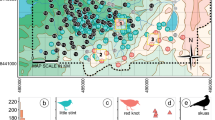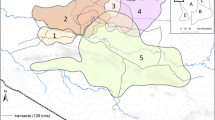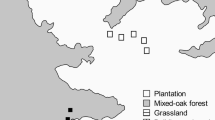Summary
Juvenile Anolis aeneus lizards tend to hatch in shady areas, migrate to clearings after hatching, migrate out of clearings when they reach subadult sizes, and remain in shady areas throughout their adult lives. A juvenile preference for clearings is suggested by the much higher juvenile densities in clearings than in shady areas, and the fact that resident, territorial juveniles live in clearings while the juveniles seen in shady areas are virtually all transients.
Clearings suitable for juveniles are very rare in undisturbed habitat, and juveniles competed for homesites within them. Resident juveniles frequently defended their homesites against transient individuals, and the density of residents in a clearing remained constant over a month despite high turnover in the identity of residents. It is suggested that the shortage of living space for juveniles is resporsible for the extreme aggressiveness of territorial juveniles relative to adults of the same species.
Six alternate hypotheses could account for the ontogenetic habitat shift from clearings to shady areas. Four were directly refuted: (1) food suitable for juveniles is more abundant in shady areas, while prey suitable for adults is more abundant in clearings, (2) perches suitable for juveniles are found in both sunny and shady areas, (3) adult aeneus do not aggressively exclude juveniles from shady areas and (4) juvenile Anolis richardi are too rare to have much impact on juvenile aeneus habitat association. There is a variety of indirect evidence suggesting that juvenile aeneus do not prefer clearings for thermal reasons. The only hypothesis strongly supported was the predation hypothesis. Anolis richardi adults eat juvenile aeneus, and juvenile Anolis show escape responses to A. richardi. A. richardi only live in shady areas, and most richardi cannot eat A. aeneus once they reach subadult sizes. It is suggested that the ontogenetic shift from clearings to shady areas in A. aeneus is due to avoidance of adult Anolis richardi habitats by those size classes of aeneus most vulnerable to richardi predation. In this species, predator avoidance may have directly contributed to a shortage of living space, and may have led to the intense territoriality and aggression among the most vulnerable size classes.
Similar content being viewed by others
References
Arnett JT (1974) Microhabitat resource utilization by Sceloporus undulatus hyacinthinus. PhD thesis, University of Arkansas, Fayetteville; Univ Microfilms 74–28:135
Baharav D (1975) Movement of the horned lizard, Phrynosoma solare. Copeia 1975:649–657
Blair WF (1960) The rusty lizard, a population study. University of Texas Press, Austin
Bohlin T (1977) Habitat selection and intercohort competition of juvenile sea-trout Salmo trutta. Oikos 29:112–117
Bradshaw SD (1971) Growth and mortality in a field population of Amphibolurus lizards exposed to seasonal cold and aridity. J Zool (Lond) 165:1–25
Coen LD, Heck KL, Abele LG (1981) Experiments on competition and predation among shrimps of seagrass meadows. Ecology 62:1484–1493
Curio E (1970) Die Selektion dreier Raupenformen eines Schwärmers (Lepidopt., Sphingidae) durch einen Anolis (Rept. Iguanidae). Z Tierpsychol 27:899–914
Devender RW Van (1975) The comparative demography of two local populations of the tropical lizard, Basiliscus basiliscus. PhD thesis, University of Michigan, Ann Arbor
Diefenbach CO (1975) Thermal preferences and thermoregulation in Caiman crocodilus. Copeia 1975:530–540
Fitch HS (1940) A field study of the growth and behavior of the fence lizard. Univ Calif Publ Zool 44:151–172
Fraser PF, Sise TE (1980) Observations on stream minnows in a patchy environment: a test of a theory of habitat distribution. Ecology 61:790–797
Goodyear CP (1973) Learned orientation in the predator avoidance behavior of mosquito fish, Gambusia affinis. Behavior 45:191–220
Gorman GC (1977) Comments on ontogenetic color change in Anolis cuvier: (Reptilia, Lacertilia, Iguanidae). J Herpetol 11:221–226
Hall DJ, Werner EE (1977) Seasonal distribution of fishes in the littoral zone of a Michigan lake. Trans Am Fish Soc 106:545–555
Harris VA (1964) The life of the rainbow lizard. Hutchinson Tropical Monographs, London
Hathaway LM (1969) Microdistribution and behavior of the collared lizard with special reference to structure. PhD thesis, Washington University, St. Louis; Univ Microfilms 69–22531
Henderson RW (1974) Aspects of the ecology of the juvenile common iguana (Iguana iguana). Herpetologica 30:327–332
Hertz PE, Huey RB (1981) Compensation for altitudinal changes in the thermal environment by some Anolis lizards on Hispaniola. Ecology 62:515–521
Hirth HF (1963) The ecology of two lizards on a tropical beach. Ecol Monogr 33:83–112
Huey RB, Hertz PE (1982) Effects of body size and slope on sprint speed of a lizard (Stellio (Agama) stellio). J Exp Biol 97:401–409
Huey RB, Webster TP (1975) Thermal biology of a solitary lizard: Anolis marmoratus on Guadeloupe, Lesser Antilles. Ecology 56:445–452
Iverson JB (1977) Behavior and ecology of the rock iguana Cyclura carinata. PhD thesis, University of Florida, Gainesville
Jackson RB (1961) The impact of predation, especially the tiger fish (Hydrocynus vittatus Cast) on African freshwater fishes. Proc Zool Soc (Lond) 136:603–622
Kaufman JE, Christensen JF (1972) IES lighting handbook, 5th edn. Illuminating Engineering Society, New York
Kelso JF, Ward FJ (1977) Unexploited percid populations of west Blue Lake, Manitoba, and their interactions. J Fish Res Board Can 34:1655–1669
Kiester AR, Slatkin M (1974) A strategy of movement and resource utilization. Theor Popul Biol 6:1–20
Kiester AR, Gorman GC, Arroyo OC (1975) Habitat selection behavior of three species of Anolis lizards. Ecology 56:220–225
Lillywhite HB, Licht P, Chelgren P (1973) The role of behavioral thermoregulation in the growth energetics of the toad, Bufo boreas. Ecology 54:375–383
Mittelbach GG (1981) Foraging efficiency and body size: a study of optimal diet and habitat use by bluegills. Ecology 62:1370–1386
Moermond TC (1979a) The influence of habitat structure on Anolis foraging behavior. Behaviour 70:147–168
Moermond TC (1979b) Habitat constraints on the behavior, morphology and community structure of Anolis lizards. Ecology 60:152–164
Moermond TC (1981) Prey-attack behavior of Anolis lizards. Z Tierpsychol 56:128–136
Ono KA (1981) The effects of habitat structure on the social behavior and spacing patterns of juvenile lizards (Anolis aeneus). PhD thesis, University of California, Davis
Porter WP, James FC (1979) Behavioral implications of mechanistic ecology II: The African rainbow lizard, Agama agama. Copeia 1979:594–619
Rand AS (1967) Ecology and social organization in the iguanid lizard Anolis lineatopus. Proc US Natl Mus Smithson Inst 122:1–79
Roughgarden J, Fuentes ER (1977) The environmental determinates of size in solitary populations of West Indian Anolis lizards. Oikos 29:44–51
Roughgarden J, Porter W, Heckel D (1981) Resource partitioning of space and its relationship to body temperature in Anolis lizard populations. Oecologia (Berl) 50:256–264
Schall JJ (1974) Population structure of the Aruban whiptail lizard, Cnemidophorus arubensis in varied habitats. Herpetologica 30:38–44
Schoener TW (1977) Competition and the niche. In: Gans C, Tinkle DW (eds) Biology of the reptilia, vol 7. Academic Press, New York
Schoener TW, Gorman GC (1968) Some niche differences in three Lesser Antillean lizards of the genus Anolis. Ecology 49:819–830
Schoener TW, Schoener A (1980) Densities, sex ratios and population structure in four species of Bahamian Anolis lizards. J Anim Ecol 49:19–53
Scott NJ, Wilson DE, Jones C, Andrews R (1976) The choice of perch dimensions by lizards of the genus Anolis (Reptilia, Lacertilia, Iguanidae). J Herpetol 10:75–84
Simon CA, Middendorf GA (1976) Resource partitioning by an iguanid lizard: temporal and microhabitat aspects. Ecology 57:1317–1320
Snyder RC (1962) Adaptations for bipedal locomotion of lizards. Am Zool 2:191–203
Stamps JA (1975) Courtship patterns, estrus periods and reproductive condition in a lizard, Anolis aeneus. Physiol Behav 14:531–535
Stamps JA (1976) Egg retention, rainfall and egg laying in a tropical lizard, Anolis aeneus. Copeia 1976:759–764
Stamps JA (1977a) The relationship between resource competition, risk and aggression in a tropical territorial lizard. Ecology 58:349–358
Stamps JA (1977b) The function of the survey posture in Anolis lizards. Copeia 1977:756–758
Stamps JA (1978) A field study of the ontogeny of social behavior in the lizard Anolis aeneus. Behaviour 66:1–31
Stamps JA (in press a) Sexual selection, sexual dimorphism and territoriality in lizards. In: Huey RB, Pianka ER, Schoener TW (eds) Lizard ecology: studies on a model organism. Harvard University Press, Cambridge
Stamps JA (in press b) Territoriality, and the defense of predator-refuges in juvenile lizards, Anim Behav
Stamps JA, Crews DP (1976) Seasonal changes in reproduction and social behavior in the lizard Anolis aeneus. Copeia 1976:467–476
Stamps JA, Tanaka SK (1981a) The influence of food and water on growth rates in a tropical lizard (Anolis aeneus). Ecology 61:33–40
Stamps JA, Tanaka SK (1981b) The relationship between food and social behavior in juvenile lizards (Anolis aeneus). Copeia 1981:422–434
Stamps JA, Tanaka SK, Krishnan VV (1981) The relationship between selectivity and food abundance in a juvenile lizard. Ecology 62:1079–1092
Stein RA (1979) Behavioral response of prey to fish predators. In: Stroud RH, Clepper H (eds) Predator-prey systems in fisheries management. Sprot Fishing Institute, Washington, DC
Sukhanov VB (1974) General system of symmetrical locomotion of terrestrial vertebrates and some features of movement of lower tetrapods. Amerind, New Delhi
Tanaka LK, Tanaka SK (1982) Rainfall and seasonal changes in arthropod abundance on a tropical oceanic island. Biotropica 14:114–123
Werner EE, Hall DJ (1979) Foraging efficiency and habitat switching in competing sunfishes. Ecology 60:256–264
Wunderle JM (1981) Avian predation upon Anolis lizards on Grenada, West Indies. Herpetologica 37:104–108
Author information
Authors and Affiliations
Rights and permissions
About this article
Cite this article
Stamps, J.A. The relationship between ontogenetic habitat shifts, competition and predator avoidance in a juvenile lizard (Anolis aeneus). Behav Ecol Sociobiol 12, 19–33 (1983). https://doi.org/10.1007/BF00296929
Received:
Accepted:
Issue Date:
DOI: https://doi.org/10.1007/BF00296929




